AI In Branding Market Size 2025-2029
The ai in branding market size is valued to increase USD 2.47 billion, at a CAGR of 16% from 2024 to 2029. Surging demand for hyper-personalization at scale will drive the ai in branding market.
Major Market Trends & Insights
- North America dominated the market and accounted for a 38% growth during the forecast period.
- By Component - Software segment was valued at USD 739.10 billion in 2023
- By Deployment - Cloud segment accounted for the largest market revenue share in 2023
Market Size & Forecast
- Market Opportunities: USD 276.92 million
- Market Future Opportunities: USD 2466.80 million
- CAGR from 2024 to 2029 : 16%
Market Summary
- In the realm of branding, Artificial Intelligence (AI) has emerged as a transformative force, driving innovation and reshaping consumer experiences. According to recent market intelligence, The market is projected to reach a value of USD15.7 billion by 2026, underscoring its growing significance. This growth is fueled by the surging demand for hyper-personalization at scale and the ascendance of multimodal AI for creating holistic brand experiences. Multimodal AI, which can process various forms of data including text, speech, and images, enables brands to engage consumers in a more nuanced and contextually relevant manner. This technology can analyze customer preferences, behaviors, and emotions to deliver personalized marketing messages, product recommendations, and customer support.
- However, the adoption of AI in branding is not without challenges. Complex data privacy, security, and ethical regulations necessitate careful navigation. Brands must ensure they are transparent about their data collection and usage practices and implement robust security measures to protect consumer data. Ethical considerations, such as ensuring AI does not perpetuate bias or infringe on privacy, are also critical. Despite these challenges, the future of AI in branding is bright. Brands that harness the power of AI to create personalized, engaging experiences will differentiate themselves from competitors and build stronger relationships with consumers. The integration of AI into branding strategies is no longer a nice-to-have, but a necessity for businesses seeking to thrive in today's digital landscape.
What will be the Size of the AI In Branding Market during the forecast period?
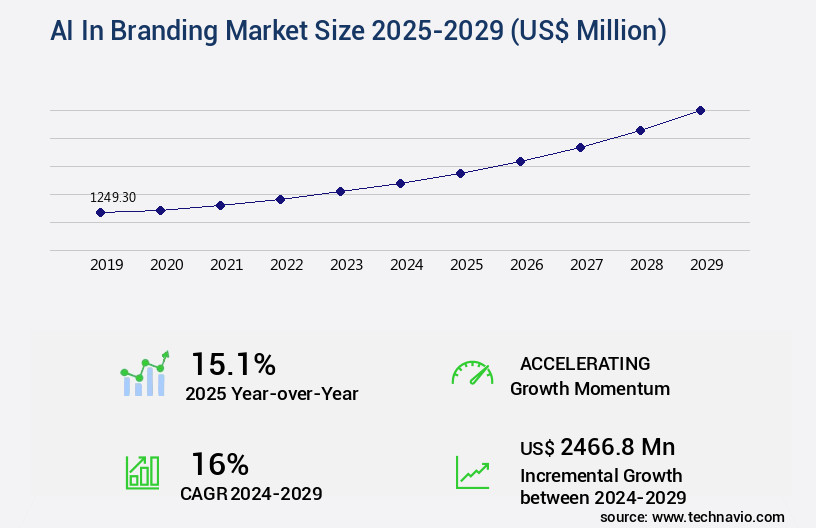
Get Key Insights on Market Forecast (PDF) Request Free Sample
How is the AI In Branding Market Segmented ?
The ai in branding industry research report provides comprehensive data (region-wise segment analysis), with forecasts and estimates in "USD million" for the period 2025-2029, as well as historical data from 2019-2023 for the following segments.
- Component
- Deployment
- Application
- Content creation and management
- Campaign optimization
- Brand monitoring and sentiment analysis
- Brand strategy development
- Others
- Geography
- North America
- Europe
- APAC
- China
- India
- Japan
- South Korea
- South America
- Rest of World (ROW)
By Component Insights
The software segment is estimated to witness significant growth during the forecast period.
The market continues to evolve, with the software segment leading the charge. This segment encompasses a multitude of platforms, applications, and tools that utilize deep learning for brand personality development and storytelling techniques, marketing automation for conversion rate optimization, customer segmentation and target audience identification, and competitive brand analysis. Machine learning algorithms power predictive analytics models for consumer behavior prediction and marketing campaign optimization, while computer vision systems facilitate brand equity measurement through visual identity design and chatbot development. Moreover, AI-driven market research and data-driven brand building employ personalization technologies and predictive analytics to enhance customer engagement and brand voice consistency.
Notably, the market's progression has seen a transition from analytical functions to generative functions, enabling AI to autonomously create high-quality text, imagery, and video content. This shift significantly alters marketing economics and campaign speed. According to recent studies, AI-generated visual content can increase engagement by up to 60%.
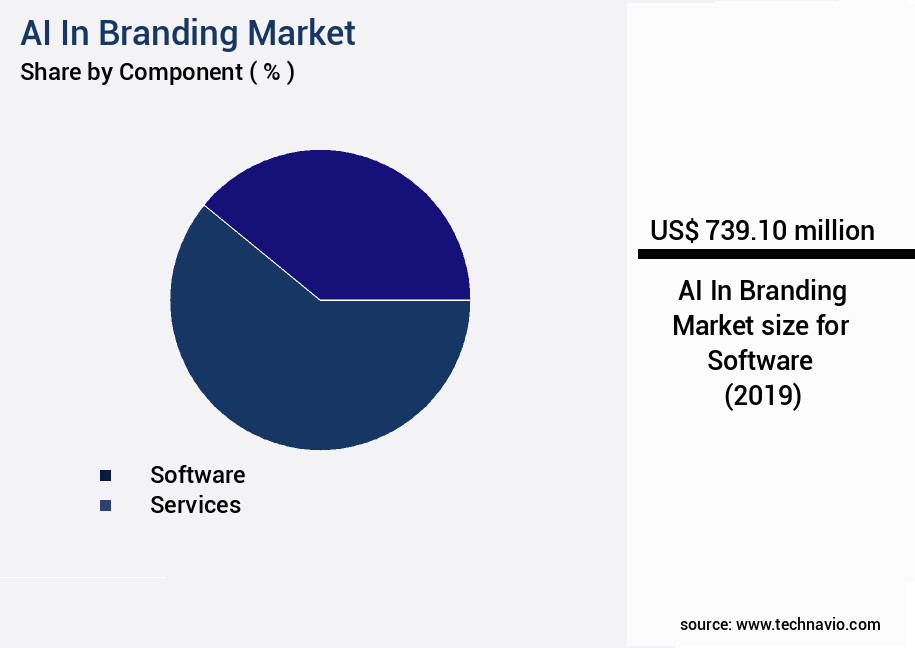
Request Free Sample
The Software segment was valued at USD 739.10 billion in 2019 and showed a gradual increase during the forecast period.
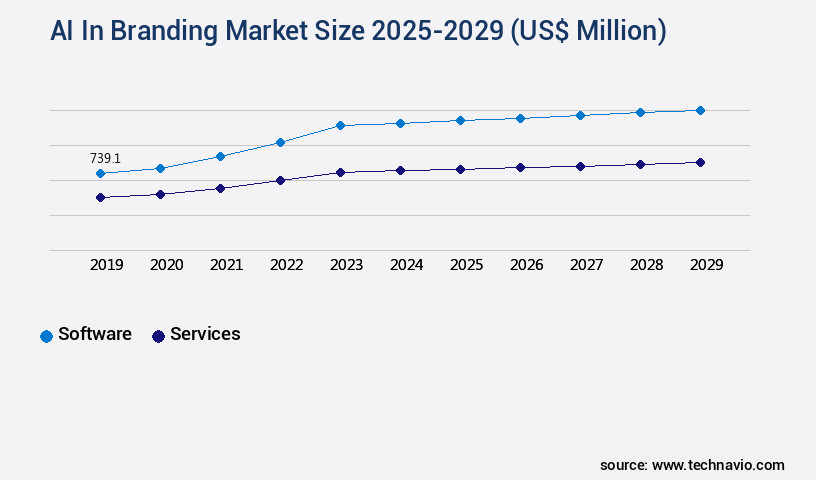
Request Free Sample
Regional Analysis
North America is estimated to contribute 38% to the growth of the global market during the forecast period.Technavio’s analysts have elaborately explained the regional trends and drivers that shape the market during the forecast period.
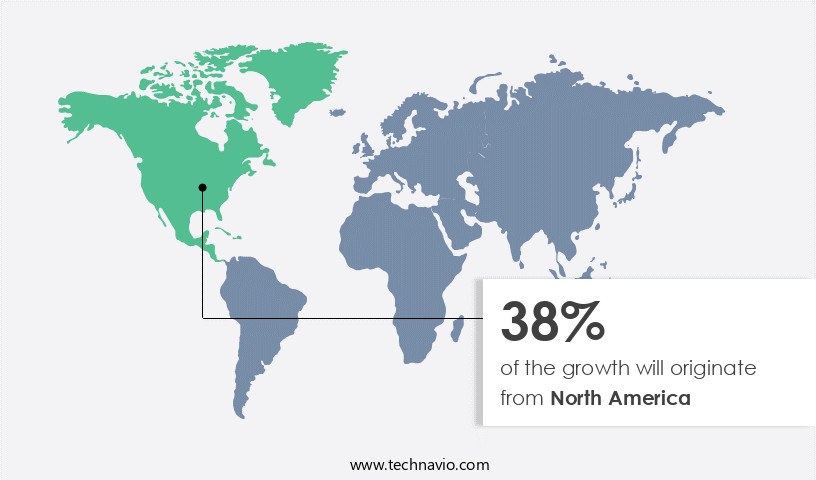
See How AI In Branding Market Demand is Rising in North America Request Free Sample
The market is witnessing significant growth, with North America leading the charge. This region, comprising the United States and Canada, is home to a thriving ecosystem that fosters AI innovation. Key players in technology and research, an abundance of venture capital, and a competitive corporate landscape create a virtuous cycle of research commercialization and adoption. Brands in North America are capitalizing on AI's capabilities to enhance their marketing and brand management strategies. According to recent studies, the North American market held a substantial market share in 2021, accounting for approximately 45% of the global revenue.
Europe follows closely, with a market share of around 30%. These figures underscore the global significance of AI in branding, with regions outside of North America and Europe poised for growth as they build their AI capabilities.
Market Dynamics
Our researchers analyzed the data with 2024 as the base year, along with the key drivers, trends, and challenges. A holistic analysis of drivers will help companies refine their marketing strategies to gain a competitive advantage.
The market is experiencing significant growth as businesses seek to leverage advanced technologies to enhance their branding strategies. AI image generation for branding is revolutionizing visual identity design, allowing brands to create unique and consistent visuals that resonate with their audience. Predictive modeling for customer segmentation using AI helps businesses understand their audience better, enabling them to tailor their messaging and marketing efforts.
Natural Language Processing (NLP) is used for brand voice consistency analysis, ensuring a uniform brand message across all channels. Automated A/B testing for marketing campaigns using machine learning algorithms allows for data-driven decision-making, maximizing campaign performance. AI-driven content creation for social media platforms keeps brands engaged with their audience, while sentiment analysis monitors brand reputation and manages customer feedback.
Deep learning applications for brand personality development provide insights into customer behavior and preferences, enabling brands to adapt and evolve. Computer vision for visual brand identity design ensures brand consistency across all visual touchpoints. Natural Language Generation (NLG) for brand storytelling creates personalized and compelling narratives that resonate with audiences.
AI-powered chatbots for customer engagement offer personalized recommendations based on customer data, improving customer experience and loyalty. Marketing automation for campaign optimization and real-time brand performance dashboards provide valuable insights for data-driven brand positioning. Social listening tools for brand awareness monitoring and AI-driven market research for brand strategy ensure businesses stay ahead of the competition.
Automated content moderation for brand safety and customer feedback analysis for brand improvement are essential components of an effective AI branding strategy, ensuring a positive brand image and reputation. AI-powered competitor brand analysis provides valuable insights into competitors' strengths and weaknesses, enabling businesses to differentiate themselves and stay competitive. The future of branding is undeniably AI-driven, offering numerous benefits for businesses looking to stand out in a crowded marketplace.
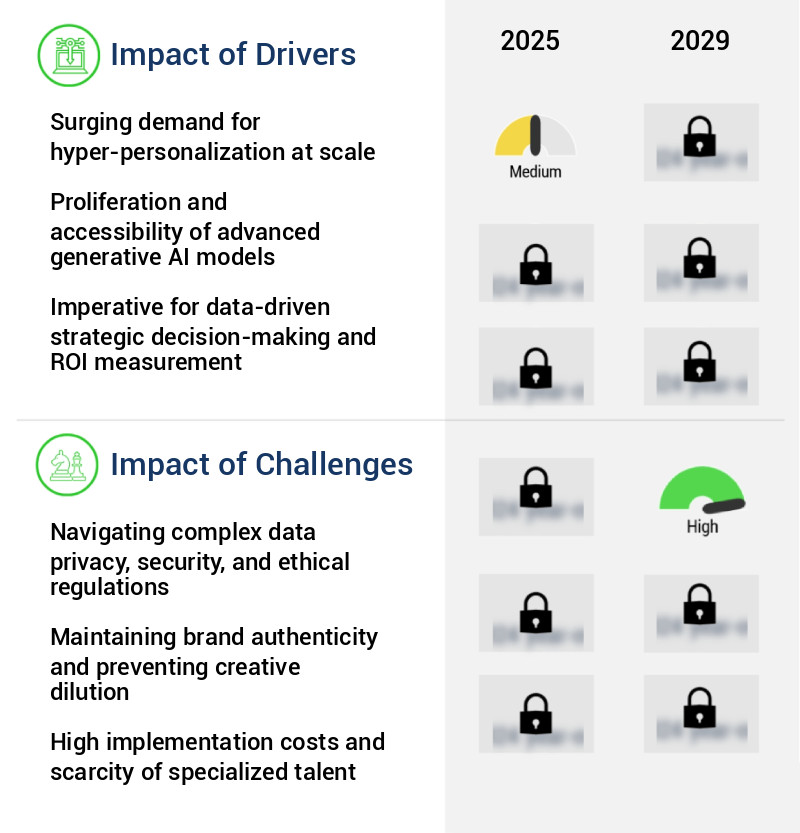
What are the key market drivers leading to the rise in the adoption of AI In Branding Industry?
- The surge in demand for hyper-personalization at scale is the primary market driver, necessitating advanced technologies and solutions to deliver customized experiences efficiently and effectively.
- The market is experiencing a significant evolution, driven by the increasing consumer demand for hyper-personalized and contextually aware interactions. Modern consumers no longer perceive brands as monolithic entities, but as partners in a one-to-one dialogue. This expectation for personalization extends throughout the customer journey, necessitating a solution to deliver individualized engagement to millions. Artificial Intelligence (AI) emerges as a critical technological response to this challenge. By employing machine learning algorithms to analyze extensive datasets, including past purchases, browsing behavior, social media activity, and real-time context, AI constructs a profound understanding of each individual. Two leading sectors, retail and marketing, have already adopted AI extensively, with AI in retail expected to reach a market size of USD39.5 billion by 2027, growing at a substantial rate.
- Similarly, the AI in marketing sector is projected to reach USD198.47 billion by 2025, demonstrating the market's robust potential. AI's ability to analyze vast datasets and provide personalized recommendations, content, and experiences makes it an indispensable tool for brands seeking to meet the evolving expectations of their consumers.
What are the market trends shaping the AI In Branding Industry?
- The ascendance of multimodal AI is the emerging market trend, enabling the creation of holistic brand experiences.
- The market is experiencing a transformative phase with the increasing implementation of multimodal AI systems. A departure from traditional AI that primarily dealt with one type of data, multimodal AI processes and comprehends information from multiple data sources - text, audio, video, and images - concurrently. This innovative approach enhances brand communication by providing a more contextually aware and nuanced understanding. For example, a multimodal AI can decipher the sentiment in a user's tone of voice, analyze the visual context of a product in use, and interpret the specific words in their commentary from a single user-generated video review.
- This integrated and sophisticated methodology sets the stage for a new era in branding, enabling more personalized, engaging, and effective interactions between consumers and brands.
What challenges does the AI In Branding Industry face during its growth?
- Compliance with intricate data privacy regulations, ensuring robust security measures, and adhering to ethical standards are essential challenges that significantly impact industry expansion.
- The market is undergoing significant evolution, with applications spanning various sectors such as marketing, advertising, and customer service. The integration of AI technologies, including machine learning and natural language processing, enables brands to deliver personalized experiences at scale. However, the market's growth is not without challenges. The intricate and demanding landscape of data privacy, security, and ethics poses a formidable obstacle. Brands must navigate a complex web of global regulations, such as the European General Data Protection Regulation (GDPR), which imposes strict consent and processing requirements. This regulatory patchwork creates substantial compliance overhead, demanding substantial investment in legal counsel and technology to avoid severe financial penalties and the erosion of consumer trust.
- According to recent estimates, the global AI in marketing market size was valued at USD3.8 billion in 2020 and is projected to reach USD68.8 billion by 2027, growing at a compound annual growth rate (CAGR) of 41.5% during the forecast period. Another study suggests that by 2025, AI will influence USD150 billion worth of consumer spending in the US alone. Despite these opportunities, brands must prioritize data privacy, security, and ethics to harness the full potential of AI in branding.
Exclusive Technavio Analysis on Customer Landscape
The ai in branding market forecasting report includes the adoption lifecycle of the market, covering from the innovator’s stage to the laggard’s stage. It focuses on adoption rates in different regions based on penetration. Furthermore, the ai in branding market report also includes key purchase criteria and drivers of price sensitivity to help companies evaluate and develop their market growth analysis strategies.
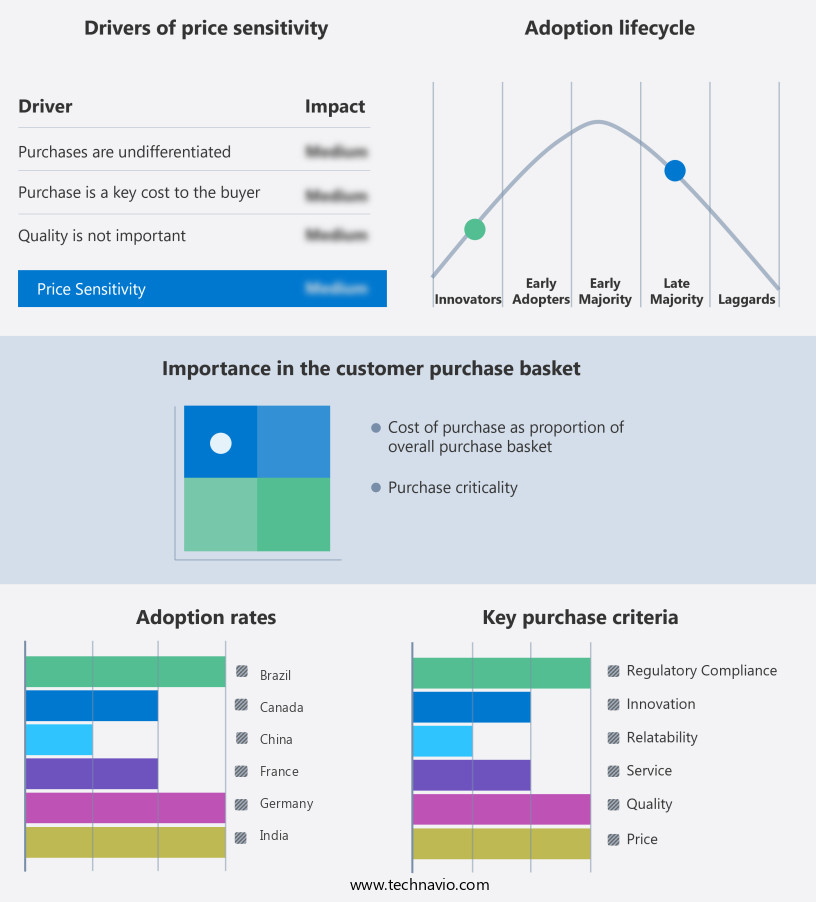
Customer Landscape of AI In Branding Industry
Competitive Landscape
Companies are implementing various strategies, such as strategic alliances, ai in branding market forecast, partnerships, mergers and acquisitions, geographical expansion, and product/service launches, to enhance their presence in the industry.
Adobe Inc. - The company's Firefly Generative Match utilizes AI technology for consistent branding. This innovative solution employs image style transfer to generate harmonized content by applying reference styles to new assets, ensuring a cohesive brand representation.
The industry research and growth report includes detailed analyses of the competitive landscape of the market and information about key companies, including:
- Adobe Inc.
- Appier Group Inc.
- Google LLC
- HEURITECH
- HeyGen
- HubSpot Inc.
- International Business Machines Corp.
- Invoca Inc.
- Jasper AI Inc.
- Kittl
- Meta Platforms Inc.
- neuroflash
- Omneky
- Persado Holdings plc
- Salesforce Inc.
- Single Grain LLC
- Sprinklr Inc.
- Synthesia Ltd.
- WPP Plc
Qualitative and quantitative analysis of companies has been conducted to help clients understand the wider business environment as well as the strengths and weaknesses of key industry players. Data is qualitatively analyzed to categorize companies as pure play, category-focused, industry-focused, and diversified; it is quantitatively analyzed to categorize companies as dominant, leading, strong, tentative, and weak.
Recent Development and News in AI In Branding Market
- In January 2024, IBM announced the launch of Watson Marketing, an AI-powered marketing platform designed to help businesses personalize customer experiences at scale (IBM Press Release). This solution uses machine learning algorithms to analyze customer data and deliver targeted marketing campaigns.
- In March 2024, Adobe and Microsoft entered into a strategic partnership to integrate Adobe Experience Cloud with Microsoft Teams and Microsoft Dynamics 365. This collaboration allows businesses to use AI-driven insights from Adobe's marketing and analytics tools directly within Microsoft's productivity and customer relationship management platforms (Adobe Press Release).
- In May 2024, AmplifyAI, a leading AI branding solutions provider, raised a USD20 million Series B funding round led by Sequoia Capital. The funding will be used to expand the company's AI-driven branding solutions and accelerate its global growth (Sequoia Capital Press Release).
- In January 2025, the European Union's General Data Protection Regulation (GDPR) was updated to include provisions for AI systems that process personal data. Companies using AI in branding must now comply with stricter data protection rules, ensuring transparency and accountability in their AI systems (EU Commission Press Release).
Dive into Technavio’s robust research methodology, blending expert interviews, extensive data synthesis, and validated models for unparalleled AI In Branding Market insights. See full methodology.
|
Market Scope
|
|
Report Coverage
|
Details
|
|
Page number
|
233
|
|
Base year
|
2024
|
|
Historic period
|
2019-2023 |
|
Forecast period
|
2025-2029
|
|
Growth momentum & CAGR
|
Accelerate at a CAGR of 16%
|
|
Market growth 2025-2029
|
USD 2466.8 million
|
|
Market structure
|
Fragmented
|
|
YoY growth 2024-2025(%)
|
15.1
|
|
Key countries
|
US, China, Germany, Japan, UK, Canada, France, India, Brazil, and South Korea
|
|
Competitive landscape
|
Leading Companies, Market Positioning of Companies, Competitive Strategies, and Industry Risks
|
Request Free Sample
Research Analyst Overview
- The AI market in branding continues to evolve, with deep learning applications revolutionizing various sectors. Brands are leveraging AI for personality development and storytelling techniques, enhancing consumer connections. Marketing automation systems and conversion rate optimization are seeing significant growth, with predictive analytics models and personalization technologies driving sales increases by up to 15%. Generative AI models and customer segmentation AI enable targeted audience identification, while competitive brand analysis provides valuable insights. Consumer behavior prediction and marketing campaign optimization ensure brand equity measurement remains accurate. Computer vision systems and chatbot development streamline visual identity design and customer engagement, respectively. AI-driven market research and brand awareness metrics offer data-driven brand building strategies.
- Emotional branding strategies are being powered by AI, with AI-powered brand strategy and influencer marketing AI shaping brand voice consistency. Sentiment analysis tools and customer engagement metrics maintain brand reputation management, while machine learning algorithms continue to refine brand messaging and creative content generation. The branding industry anticipates a 16% industry growth rate in the next five years, as AI continues to unfold and redefine branding applications. For instance, a leading fashion brand increased sales by 12% by implementing AI-driven customer segmentation and personalized marketing campaigns.
What are the Key Data Covered in this AI In Branding Market Research and Growth Report?
-
What is the expected growth of the AI In Branding Market between 2025 and 2029?
-
What segmentation does the market report cover?
-
The report is segmented by Component (Software and Services), Deployment (Cloud and On premises), Application (Content creation and management, Campaign optimization, Brand monitoring and sentiment analysis, Brand strategy development, and Others), and Geography (North America, APAC, Europe, Middle East and Africa, and South America)
-
Which regions are analyzed in the report?
-
North America, APAC, Europe, Middle East and Africa, and South America
-
What are the key growth drivers and market challenges?
-
Surging demand for hyper-personalization at scale, Navigating complex data privacy, security, and ethical regulations
-
Who are the major players in the AI In Branding Market?
-
Adobe Inc., Appier Group Inc., Google LLC, HEURITECH, HeyGen, HubSpot Inc., International Business Machines Corp., Invoca Inc., Jasper AI Inc., Kittl, Meta Platforms Inc., neuroflash, Omneky, Persado Holdings plc, Salesforce Inc., Single Grain LLC, Sprinklr Inc., Synthesia Ltd., and WPP Plc
Market Research Insights
- The market for AI in branding continues to evolve, with an increasing number of companies integrating artificial intelligence into their branding strategies. Two notable areas of application are customer feedback analysis and personalized customer experiences. For instance, a leading retailer reported a 15% increase in customer satisfaction ratings after implementing AI-powered chatbots to handle customer inquiries. Additionally, industry experts anticipate that the global AI in marketing market will grow by 25% annually over the next five years, driven by the demand for real-time data analytics and brand performance dashboards.
- AI-driven design tools, brand trust metrics, and dynamic pricing strategies are also gaining popularity, enabling brands to optimize sales funnels, brand refresh strategies, and marketing campaign effectiveness. Other applications include customer journey mapping, brand guideline automation, and marketing campaign automation. Overall, AI is revolutionizing branding by providing valuable insights, automating repetitive tasks, and enhancing the customer experience.
We can help! Our analysts can customize this ai in branding market research report to meet your requirements.
Get in touch
1 Executive Summary
- 1.1 Market overview
- Executive Summary - Chart on Market Overview
- Executive Summary - Data Table on Market Overview
- Executive Summary - Chart on Global Market Characteristics
- Executive Summary - Chart on Market by Geography
- Executive Summary - Chart on Market Segmentation by Component
- Executive Summary - Chart on Market Segmentation by Deployment
- Executive Summary - Chart on Market Segmentation by Application
- Executive Summary - Chart on Incremental Growth
- Executive Summary - Data Table on Incremental Growth
- Executive Summary - Chart on Company Market Positioning
2 Technavio Analysis
- 2.1 Analysis of price sensitivity, lifecycle, customer purchase basket, adoption rates, and purchase criteria
- Analysis of price sensitivity, lifecycle, customer purchase basket, adoption rates, and purchase criteria
- 2.2 Criticality of inputs and Factors of differentiation
- Overview on criticality of inputs and factors of differentiation
- 2.3 Factors of disruption
- Overview on factors of disruption
- 2.4 Impact of drivers and challenges
- Impact of drivers and challenges in 2024 and 2029
3 Market Landscape
- 3.1 Market ecosystem
- Parent Market
- Data Table on - Parent Market
- 3.2 Market characteristics
- Market characteristics analysis
4 Market Sizing
- 4.1 Market definition
- Offerings of companies included in the market definition
- 4.2 Market segment analysis
- 4.4 Market outlook: Forecast for 2024-2029
- Chart on Global - Market size and forecast 2024-2029 ($ million)
- Data Table on Global - Market size and forecast 2024-2029 ($ million)
- Chart on Global Market: Year-over-year growth 2024-2029 (%)
- Data Table on Global Market: Year-over-year growth 2024-2029 (%)
5 Historic Market Size
- 5.1 Global AI In Branding Market 2019 - 2023
- Historic Market Size - Data Table on Global AI In Branding Market 2019 - 2023 ($ million)
- 5.2 Component segment analysis 2019 - 2023
- Historic Market Size - Component Segment 2019 - 2023 ($ million)
- 5.3 Deployment segment analysis 2019 - 2023
- Historic Market Size - Deployment Segment 2019 - 2023 ($ million)
- 5.4 Application segment analysis 2019 - 2023
- Historic Market Size - Application Segment 2019 - 2023 ($ million)
- 5.5 Geography segment analysis 2019 - 2023
- Historic Market Size - Geography Segment 2019 - 2023 ($ million)
- 5.6 Country segment analysis 2019 - 2023
- Historic Market Size - Country Segment 2019 - 2023 ($ million)
6 Five Forces Analysis
- 6.1 Five forces summary
- Five forces analysis - Comparison between 2024 and 2029
- 6.2 Bargaining power of buyers
- Bargaining power of buyers - Impact of key factors 2024 and 2029
- 6.3 Bargaining power of suppliers
- Bargaining power of suppliers - Impact of key factors in 2024 and 2029
- 6.4 Threat of new entrants
- Threat of new entrants - Impact of key factors in 2024 and 2029
- 6.5 Threat of substitutes
- Threat of substitutes - Impact of key factors in 2024 and 2029
- 6.6 Threat of rivalry
- Threat of rivalry - Impact of key factors in 2024 and 2029
- 6.7 Market condition
- Chart on Market condition - Five forces 2024 and 2029
7 Market Segmentation by Component
- 7.1 Market segments
- Chart on Component - Market share 2024-2029 (%)
- Data Table on Component - Market share 2024-2029 (%)
- 7.2 Comparison by Component
- Chart on Comparison by Component
- Data Table on Comparison by Component
- 7.3 Software - Market size and forecast 2024-2029
- Chart on Software - Market size and forecast 2024-2029 ($ million)
- Data Table on Software - Market size and forecast 2024-2029 ($ million)
- Chart on Software - Year-over-year growth 2024-2029 (%)
- Data Table on Software - Year-over-year growth 2024-2029 (%)
- 7.4 Services - Market size and forecast 2024-2029
- Chart on Services - Market size and forecast 2024-2029 ($ million)
- Data Table on Services - Market size and forecast 2024-2029 ($ million)
- Chart on Services - Year-over-year growth 2024-2029 (%)
- Data Table on Services - Year-over-year growth 2024-2029 (%)
- 7.5 Market opportunity by Component
- Market opportunity by Component ($ million)
- Data Table on Market opportunity by Component ($ million)
8 Market Segmentation by Deployment
- 8.1 Market segments
- Chart on Deployment - Market share 2024-2029 (%)
- Data Table on Deployment - Market share 2024-2029 (%)
- 8.2 Comparison by Deployment
- Chart on Comparison by Deployment
- Data Table on Comparison by Deployment
- 8.3 Cloud - Market size and forecast 2024-2029
- Chart on Cloud - Market size and forecast 2024-2029 ($ million)
- Data Table on Cloud - Market size and forecast 2024-2029 ($ million)
- Chart on Cloud - Year-over-year growth 2024-2029 (%)
- Data Table on Cloud - Year-over-year growth 2024-2029 (%)
- 8.4 On premises - Market size and forecast 2024-2029
- Chart on On premises - Market size and forecast 2024-2029 ($ million)
- Data Table on On premises - Market size and forecast 2024-2029 ($ million)
- Chart on On premises - Year-over-year growth 2024-2029 (%)
- Data Table on On premises - Year-over-year growth 2024-2029 (%)
- 8.5 Market opportunity by Deployment
- Market opportunity by Deployment ($ million)
- Data Table on Market opportunity by Deployment ($ million)
9 Market Segmentation by Application
- 9.1 Market segments
- Chart on Application - Market share 2024-2029 (%)
- Data Table on Application - Market share 2024-2029 (%)
- 9.2 Comparison by Application
- Chart on Comparison by Application
- Data Table on Comparison by Application
- 9.3 Content creation and management - Market size and forecast 2024-2029
- Chart on Content creation and management - Market size and forecast 2024-2029 ($ million)
- Data Table on Content creation and management - Market size and forecast 2024-2029 ($ million)
- Chart on Content creation and management - Year-over-year growth 2024-2029 (%)
- Data Table on Content creation and management - Year-over-year growth 2024-2029 (%)
- 9.4 Campaign optimization - Market size and forecast 2024-2029
- Chart on Campaign optimization - Market size and forecast 2024-2029 ($ million)
- Data Table on Campaign optimization - Market size and forecast 2024-2029 ($ million)
- Chart on Campaign optimization - Year-over-year growth 2024-2029 (%)
- Data Table on Campaign optimization - Year-over-year growth 2024-2029 (%)
- 9.5 Brand monitoring and sentiment analysis - Market size and forecast 2024-2029
- Chart on Brand monitoring and sentiment analysis - Market size and forecast 2024-2029 ($ million)
- Data Table on Brand monitoring and sentiment analysis - Market size and forecast 2024-2029 ($ million)
- Chart on Brand monitoring and sentiment analysis - Year-over-year growth 2024-2029 (%)
- Data Table on Brand monitoring and sentiment analysis - Year-over-year growth 2024-2029 (%)
- 9.6 Brand strategy development - Market size and forecast 2024-2029
- Chart on Brand strategy development - Market size and forecast 2024-2029 ($ million)
- Data Table on Brand strategy development - Market size and forecast 2024-2029 ($ million)
- Chart on Brand strategy development - Year-over-year growth 2024-2029 (%)
- Data Table on Brand strategy development - Year-over-year growth 2024-2029 (%)
- 9.7 Others - Market size and forecast 2024-2029
- Chart on Others - Market size and forecast 2024-2029 ($ million)
- Data Table on Others - Market size and forecast 2024-2029 ($ million)
- Chart on Others - Year-over-year growth 2024-2029 (%)
- Data Table on Others - Year-over-year growth 2024-2029 (%)
- 9.8 Market opportunity by Application
- Market opportunity by Application ($ million)
- Data Table on Market opportunity by Application ($ million)
10 Customer Landscape
- 10.1 Customer landscape overview
- Analysis of price sensitivity, lifecycle, customer purchase basket, adoption rates, and purchase criteria
11 Geographic Landscape
- 11.1 Geographic segmentation
- Chart on Market share by geography 2024-2029 (%)
- Data Table on Market share by geography 2024-2029 (%)
- 11.2 Geographic comparison
- Chart on Geographic comparison
- Data Table on Geographic comparison
- 11.3 North America - Market size and forecast 2024-2029
- Chart on North America - Market size and forecast 2024-2029 ($ million)
- Data Table on North America - Market size and forecast 2024-2029 ($ million)
- Chart on North America - Year-over-year growth 2024-2029 (%)
- Data Table on North America - Year-over-year growth 2024-2029 (%)
- 11.4 APAC - Market size and forecast 2024-2029
- Chart on APAC - Market size and forecast 2024-2029 ($ million)
- Data Table on APAC - Market size and forecast 2024-2029 ($ million)
- Chart on APAC - Year-over-year growth 2024-2029 (%)
- Data Table on APAC - Year-over-year growth 2024-2029 (%)
- 11.5 Europe - Market size and forecast 2024-2029
- Chart on Europe - Market size and forecast 2024-2029 ($ million)
- Data Table on Europe - Market size and forecast 2024-2029 ($ million)
- Chart on Europe - Year-over-year growth 2024-2029 (%)
- Data Table on Europe - Year-over-year growth 2024-2029 (%)
- 11.6 Middle East and Africa - Market size and forecast 2024-2029
- Chart on Middle East and Africa - Market size and forecast 2024-2029 ($ million)
- Data Table on Middle East and Africa - Market size and forecast 2024-2029 ($ million)
- Chart on Middle East and Africa - Year-over-year growth 2024-2029 (%)
- Data Table on Middle East and Africa - Year-over-year growth 2024-2029 (%)
- 11.7 South America - Market size and forecast 2024-2029
- Chart on South America - Market size and forecast 2024-2029 ($ million)
- Data Table on South America - Market size and forecast 2024-2029 ($ million)
- Chart on South America - Year-over-year growth 2024-2029 (%)
- Data Table on South America - Year-over-year growth 2024-2029 (%)
- 11.8 US - Market size and forecast 2024-2029
- Chart on US - Market size and forecast 2024-2029 ($ million)
- Data Table on US - Market size and forecast 2024-2029 ($ million)
- Chart on US - Year-over-year growth 2024-2029 (%)
- Data Table on US - Year-over-year growth 2024-2029 (%)
- 11.9 China - Market size and forecast 2024-2029
- Chart on China - Market size and forecast 2024-2029 ($ million)
- Data Table on China - Market size and forecast 2024-2029 ($ million)
- Chart on China - Year-over-year growth 2024-2029 (%)
- Data Table on China - Year-over-year growth 2024-2029 (%)
- 11.10 Germany - Market size and forecast 2024-2029
- Chart on Germany - Market size and forecast 2024-2029 ($ million)
- Data Table on Germany - Market size and forecast 2024-2029 ($ million)
- Chart on Germany - Year-over-year growth 2024-2029 (%)
- Data Table on Germany - Year-over-year growth 2024-2029 (%)
- 11.11 Japan - Market size and forecast 2024-2029
- Chart on Japan - Market size and forecast 2024-2029 ($ million)
- Data Table on Japan - Market size and forecast 2024-2029 ($ million)
- Chart on Japan - Year-over-year growth 2024-2029 (%)
- Data Table on Japan - Year-over-year growth 2024-2029 (%)
- 11.12 UK - Market size and forecast 2024-2029
- Chart on UK - Market size and forecast 2024-2029 ($ million)
- Data Table on UK - Market size and forecast 2024-2029 ($ million)
- Chart on UK - Year-over-year growth 2024-2029 (%)
- Data Table on UK - Year-over-year growth 2024-2029 (%)
- 11.13 Canada - Market size and forecast 2024-2029
- Chart on Canada - Market size and forecast 2024-2029 ($ million)
- Data Table on Canada - Market size and forecast 2024-2029 ($ million)
- Chart on Canada - Year-over-year growth 2024-2029 (%)
- Data Table on Canada - Year-over-year growth 2024-2029 (%)
- 11.14 India - Market size and forecast 2024-2029
- Chart on India - Market size and forecast 2024-2029 ($ million)
- Data Table on India - Market size and forecast 2024-2029 ($ million)
- Chart on India - Year-over-year growth 2024-2029 (%)
- Data Table on India - Year-over-year growth 2024-2029 (%)
- 11.15 France - Market size and forecast 2024-2029
- Chart on France - Market size and forecast 2024-2029 ($ million)
- Data Table on France - Market size and forecast 2024-2029 ($ million)
- Chart on France - Year-over-year growth 2024-2029 (%)
- Data Table on France - Year-over-year growth 2024-2029 (%)
- 11.16 South Korea - Market size and forecast 2024-2029
- Chart on South Korea - Market size and forecast 2024-2029 ($ million)
- Data Table on South Korea - Market size and forecast 2024-2029 ($ million)
- Chart on South Korea - Year-over-year growth 2024-2029 (%)
- Data Table on South Korea - Year-over-year growth 2024-2029 (%)
- 11.17 Brazil - Market size and forecast 2024-2029
- Chart on Brazil - Market size and forecast 2024-2029 ($ million)
- Data Table on Brazil - Market size and forecast 2024-2029 ($ million)
- Chart on Brazil - Year-over-year growth 2024-2029 (%)
- Data Table on Brazil - Year-over-year growth 2024-2029 (%)
- 11.18 Market opportunity by geography
- Market opportunity by geography ($ million)
- Data Tables on Market opportunity by geography ($ million)
12 Drivers, Challenges, and Opportunity/Restraints
- 12.3 Impact of drivers and challenges
- Impact of drivers and challenges in 2024 and 2029
- 12.4 Market opportunities/restraints
13 Competitive Landscape
- 13.2 Competitive Landscape
- Overview on criticality of inputs and factors of differentiation
- 13.3 Landscape disruption
- Overview on factors of disruption
- 13.4 Industry risks
- Impact of key risks on business
14 Competitive Analysis
- 14.2 Company ranking index
- 14.3 Market positioning of companies
- Matrix on companies position and classification
- 14.4 Adobe Inc.
- Adobe Inc. - Overview
- Adobe Inc. - Business segments
- Adobe Inc. - Key news
- Adobe Inc. - Key offerings
- Adobe Inc. - Segment focus
- SWOT
- 14.5 Appier Group Inc.
- Appier Group Inc. - Overview
- Appier Group Inc. - Product / Service
- Appier Group Inc. - Key offerings
- SWOT
- 14.6 Google LLC
- Google LLC - Overview
- Google LLC - Product / Service
- Google LLC - Key offerings
- SWOT
- 14.7 HeyGen
- HeyGen - Overview
- HeyGen - Product / Service
- HeyGen - Key offerings
- SWOT
- 14.8 HubSpot Inc.
- HubSpot Inc. - Overview
- HubSpot Inc. - Product / Service
- HubSpot Inc. - Key offerings
- SWOT
- 14.9 International Business Machines Corp.
- International Business Machines Corp. - Overview
- International Business Machines Corp. - Business segments
- International Business Machines Corp. - Key news
- International Business Machines Corp. - Key offerings
- International Business Machines Corp. - Segment focus
- SWOT
- 14.10 Invoca Inc.
- Invoca Inc. - Overview
- Invoca Inc. - Product / Service
- Invoca Inc. - Key offerings
- SWOT
- 14.11 Jasper AI Inc.
- Jasper AI Inc. - Overview
- Jasper AI Inc. - Product / Service
- Jasper AI Inc. - Key offerings
- SWOT
- 14.12 Kittl
- Kittl - Overview
- Kittl - Product / Service
- Kittl - Key offerings
- SWOT
- 14.13 Meta Platforms Inc.
- Meta Platforms Inc. - Overview
- Meta Platforms Inc. - Business segments
- Meta Platforms Inc. - Key offerings
- Meta Platforms Inc. - Segment focus
- SWOT
- 14.14 Persado Holdings plc
- Persado Holdings plc - Overview
- Persado Holdings plc - Product / Service
- Persado Holdings plc - Key offerings
- SWOT
- 14.15 Salesforce Inc.
- Salesforce Inc. - Overview
- Salesforce Inc. - Product / Service
- Salesforce Inc. - Key news
- Salesforce Inc. - Key offerings
- SWOT
- 14.16 Sprinklr Inc.
- Sprinklr Inc. - Overview
- Sprinklr Inc. - Product / Service
- Sprinklr Inc. - Key offerings
- SWOT
- 14.17 Synthesia Ltd.
- Synthesia Ltd. - Overview
- Synthesia Ltd. - Product / Service
- Synthesia Ltd. - Key offerings
- SWOT
- 14.18 WPP Plc
- WPP Plc - Overview
- WPP Plc - Product / Service
- WPP Plc - Key offerings
- SWOT
15 Appendix
- 15.2 Inclusions and exclusions checklist
- Inclusions checklist
- Exclusions checklist
- 15.3 Currency conversion rates for US$
- Currency conversion rates for US$
- 15.4 Research methodology
- 15.7 Validation techniques employed for market sizing
- Validation techniques employed for market sizing
- 15.9 360 degree market analysis
- 360 degree market analysis
- 15.10 List of abbreviations







![]() Get the report (PDF) sent to your email within minutes.
Get the report (PDF) sent to your email within minutes.
Complimentary full Excel data with your report purchase.